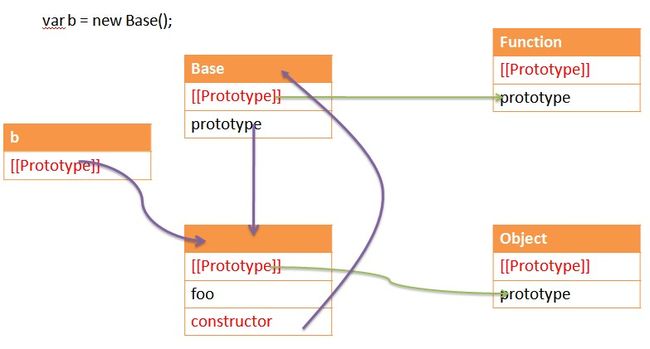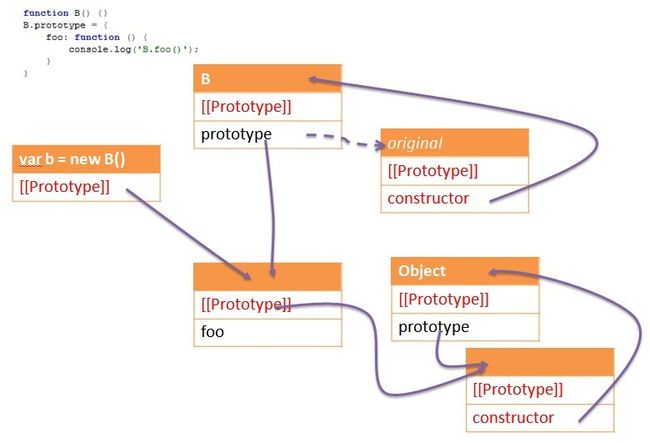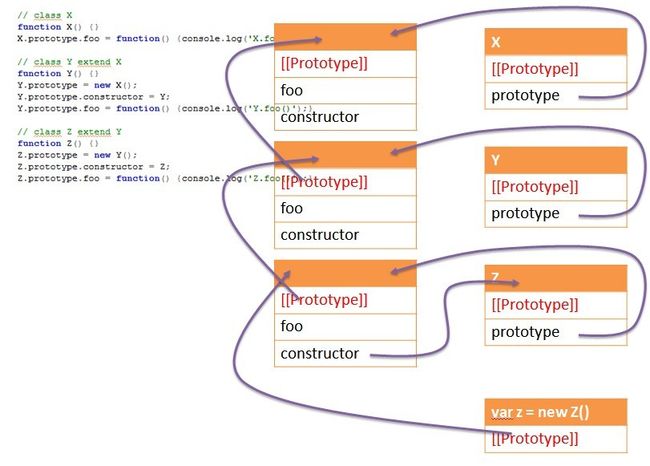原型链补充
javascript constructor 详解
2010-04-26 22:19
constructor属性始终指向创建当前对象的构造函数。比如下面例子:
//
等价于 var foo = new Array(1, 56, 34, 12);
var
arr
=
[
1
,
56
,
34
,
12
]; console.log(arr.constructor
===
Array);
//
true
//
等价于 var foo = new Function();
var
Foo
=
function
() { }; console.log(Foo.constructor
===
Function);
//
true
//
由构造函数实例化一个obj对象
var
obj
=
new
Foo(); console.log(obj.constructor
===
Foo);
//
true
//
将上面两段代码合起来,就得到下面的结论
console.log(obj.constructor.constructor
===
Function);
//
true
但是当constructor遇到prototype时,有趣的事情就发生了。
我们知道每个函数都有一个默认的属性prototype,而这个prototype的constructor默认指向这个函数。如下例所示:
function Person(name) { this .name = name; }; Person.prototype.getName = function () { return this .name; }; var p = new Person( " ZhangSan " ); console.log(p.constructor === Person); // true console.log(Person.prototype.constructor === Person); // true // 将上两行代码合并就得到如下结果 console.log(p.constructor.prototype.constructor === Person); // true
当时当我们重新定义函数的prototype时(注意:和上例的区别,这里不是修改而是覆盖),constructor属性的行为就有点奇怪了,如下示例:
function Person(name) { this .name = name; }; Person.prototype = { getName: function () { return this .name; } }; var p = new Person( " ZhangSan " ); console.log(p.constructor === Person); // false console.log(Person.prototype.constructor === Person); // false console.log(p.constructor.prototype.constructor === Person); // false
为什么呢?
原来是因为覆盖Person.prototype时,等价于进行如下代码操作:
Person.prototype = new Object({ getName: function () { return this .name; } });
看到这里可能有童鞋会问为什么改prototype的值会让p.constructor 的值改变呢,其实单纯的function里没有constructor属性,但为什么可以访问,因为当访问一个不存在的属性的时候,JS会找改属性在原型链里存在与否,其实也就是JS继承的实现,结果发现原型链里有,所以,如上例,p.constructor跟p.prototype.constructor是同一个东西来的,不信你修改p.prototype.constructor就知道了,如下文,但你修改p.constructor就不会影响到p.prototype.consturctor,相当于重写了一个方法(add lonely 2011-9-28)
而constructor属性始终指向创建自身的构造函数,所以此时Person.prototype.constructor === Object,即是:
function Person(name) { this .name = name; }; Person.prototype = { getName: function () { return this .name; } }; var p = new Person( " ZhangSan " ); console.log(p.constructor === Object); // true console.log(Person.prototype.constructor === Object); // true console.log(p.constructor.prototype.constructor === Object); // true
怎么修正这种问题呢?方法也很简单,重新覆盖Person.prototype.constructor即可:
function Person(name) { this .name = name; }; Person.prototype = new Object({ getName: function () { return this .name; } }); Person.prototype.constructor = Person; var p = new Person( " ZhangSan " ); console.log(p.constructor === Person); // true console.log(Person.prototype.constructor === Person); // true console.log(p.constructor.prototype.constructor === Person); // true


